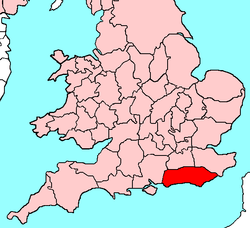Sussex
| Sussex | |
|---|---|
 Flag of Sussex |
|
 Ancient extent of Sussex |
|
| Area | |
| • 1901 | 932,409 acres (3,773 km2) |
| • 2011 | 934,900 acres (3,783 km2) |
| • Coordinates | 51°N 0°E / 51°N 0°ECoordinates: 51°N 0°E / 51°N 0°E |
| Population | |
| • 1901 | 602,255 |
| • 2011 | 1,609,500 |
| Density | |
| • 1901 | 0.6 inhabitants per acre (150/km2) |
| • 2011 | 1.72 inhabitants per acre (430/km2) |
| History | |
| • Origin | Kingdom of Sussex |
| • Created | 5th century |
| • Succeeded by | East Sussex and West Sussex |
| Status |
Historic county (current) Ceremonial county (until 1974) |
| Chapman code | SSX |
| • HQ | Chichester or Lewes |
| • Motto | "We wunt be druv" |
| Subdivisions | |
| • Type | Rapes |
Sussex (/ˈsʌsᵻks/; abbreviated Sx), from the Old English Sūþsēaxe (South Saxons), is a historic county in South East England corresponding roughly in area to the ancient Kingdom of Sussex. It is bounded to the west by Hampshire, north by Surrey, north-east by Kent, south by the English Channel, and divided for local government into West Sussex and East Sussex and the city of Brighton and Hove. Brighton and Hove was created as a unitary authority in 1997, and granted City status in 2000. Until then, Chichester was Sussex's only city.
Sussex has three main geographic sub-regions, each oriented approximately east to west. In the south-west is the fertile and densely populated coastal plain. North of this are the rolling chalk hills of the South Downs, beyond which is the well-wooded Sussex Weald.
The name derives from the Kingdom of Sussex, which was founded, according to legend, by Ælle of Sussex in AD 477. In 825, it was absorbed into the kingdom of Wessex and subsequently into the kingdom of England. It was the home of some of Europe's earliest hominids, whose remains have been found at Boxgrove, and was invaded by the Romans and is the site of the Battle of Hastings.
...
Wikipedia
